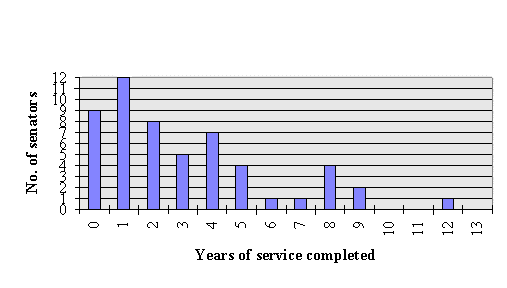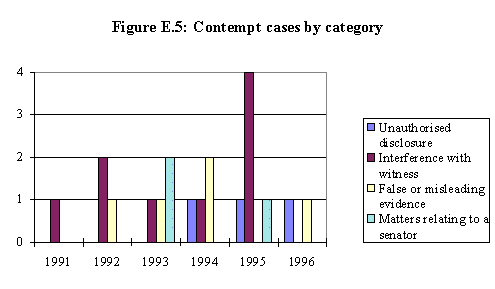APPENDIX E
WORK OF THE PRIVILEGES COMMITTEE:
SOME FACTS AND FIGURES
References
Since 1966, 71 matters have been referred to the Committee of Privileges.
On two occasions, the committee reported on two related references within
the one report (nos. 43 and 50), and in the committee's first general
report (no. 35), it reported on four right-of-reply matters which were
not proceeded with or which were resolved in another fashion. Two matters
are currently under consideration by the committee. On two other occasions,
references lapsed at the termination of a Parliament and were not pursued
by the incoming committee in the new Parliament. These two references
have been excluded from all subsequent analysis.
Geographic source of references
References may be sourced from more than one location. As shown in Fig.
E.1, the majority of the committee's references since February 1988, including
those it has not as yet reported on, have come from 'national' sources.
That is, they were generated partly or solely from federal government
departments or agencies, or involved senators, or committees considering
estimates.

Two states, New South Wales and Western Australia, have been the source
of the greatest number of right-of-reply references, with eight each,
while Queensland has generated most of the state-sourced contempt cases.
Public Service involvement
Since the committee's inception, of the 41 references broadly categorised
as involving possible contempt, 14 have involved public servants or statutory
office-holders. Since February 1988, 11 references have involved Commonwealth
public servants or statutory office-holders and one has involved Territory
public servants. Cases have been divided fairly equally between departmental
public servants and officers in statutory authorities. Since 1988, three
of the references have been in the customs field, three in aboriginal
affairs, two in health/community services, two in defence and one each
in criminal justice and business law. Allowing for references involving
more than one type of contempt, six involved the possible giving of false
or misleading evidence; six involved possible threat or penalty to a witness;
and one the unauthorised disclosure of information.
Conduct of inquiries
Contempt
On receiving a reference, the Committee of Privileges seeks, in writing,
input from the persons involved. It provides them with all relevant evidence
and invites a response. Such responses normally elicit more questions
from the committee, which seeks to answer them by providing the further
documentation it has received from the complainant to other persons involved,
and vice versa, and inviting further written submissions. Claim and counterclaim
can be traded through the committee until it is satisfied that it has
sufficient reliable evidence on which to reach its conclusions. In the
event that the committee feels it needs to hear evidence in person from
the persons involved, it will invite them to a public hearing. This is
the exception, however, rather than the rule. Since its inception, the
committee has held public hearings into only seven matters. Since the
adoption of the Senate privilege resolutions in 1988, the committee has
held nine days of public hearings, on six separate references, five of
which were possible contempt matters. In more than three-quarters of possible
contempt cases, the committee has not found it necessary to take oral
evidence.
Duration
The length of time taken by the committee to complete an inquiry depends
on a number of factors: the inherent complexity of the reference; the
number of references under consideration simultaneously; the promptness
of responses from participants; the interruptions brought about by parliamentary
elections; the vagaries of the parliamentary calendar; and the type of
reference. From reference to report, the committee's inquiries have ranged
in time taken from one day ( Report no. 34) to 21 months (Report no. 57).
The average duration of right-of-reply references has been 40 days, with
16 being completed within one month and 8 within one week. Right-of-reply
cases can generally be handled swiftly, with the co-operation of the person
seeking to make a response. References which involve public hearings tend
to take a little longer to finalise than others - 7.5 months as opposed
to 6.8 months.
Advice
The Privileges Committee has sought advice to assist it from several
sources, but primarily from the Clerk of the Senate. He has provided written
advice on 19 occasions and on 15 occasions the committee has published
that advice, in whole or in part, in a report or associated documentation.1
The committee has sought assistance from legal counsel only twice in
relation to contempt matters. In one case, this involved an evaluation
of written material; the second dealt with a complex matter in which both
witnesses and those against whom allegations were made were all lawyers
working under an act of parliament. In each case the counsel chosen by
the committee, now a judge of the NSW Supreme Court, had appeared as amicus
curiae and had assisted two select committees in relation to the conduct
of the late Mr Justice Murphy.
Reports
Between its establishment and the end of April 1996, the committee tabled,
or presented to the President, 61 reports. Ten were tabled in the years
between 1966 and the passage of the Parliamentary Privileges Act 1987
and the Senate Privilege Resolutions on 25 February 1988; 51 have
been tabled in the eight years since.
Figure E.2: No. of reports tabled per year, 1971-April
1996

As Figure E.2 shows, the committee's activities prior to 1988 were spasmodic,
with little or no 'bunching' of references. Since 1988, however, many
more demands have been placed on the committee. The busiest year to date
has been 1995, during which nine privilege reports were tabled.
Not only has the committee tabled more reports but it has had fewer breaks
between references. As Table E.1 shows, since November 1988 the committee
has not been without an active reference and at times has had as many
as eight active references.
Table E.1: Number of privilege inquiries underway per month
| Jan |
|
4 |
1 |
3 |
1 |
2 |
6 |
6 |
4 |
| Feb |
|
4 |
3 |
3 |
1 |
2 |
6 |
6 |
4 |
| Mar |
1 |
4 |
3 |
3 |
1 |
2 |
6 |
7 |
4 |
| Apr |
1 |
4 |
3 |
1 |
2 |
2 |
5 |
5 |
4 |
| May |
1 |
4 |
3 |
1 |
2 |
4 |
8 |
5 |
|
| Jun |
1 |
3 |
1 |
2 |
2 |
2 |
8 |
8 |
|
| Jul |
|
1 |
2 |
1 |
1 |
2 |
7 |
5 |
|
| Aug |
|
2 |
3 |
2 |
2 |
3 |
7 |
6 |
|
| Sep |
|
3 |
3 |
2 |
2 |
4 |
7 |
6 |
|
| Oct |
|
3 |
3 |
1 |
3 |
5 |
6 |
6 |
|
| Nov |
3 |
2 |
4 |
2 |
3 |
6 |
7 |
5 |
|
| Dec |
6 |
3 |
5 |
1 |
3 |
7 |
7 |
5 |
|
| |
1988 |
1989 |
1990 |
1991 |
1992 |
1993 |
1994 |
1995 |
1996 |
The 61 reports tabled or presented between 1966 and April 1996 can be
categorised as follows, with a number of reports falling into more than
one category: 22 dealt with right-of-reply cases; 12 with possible threats
or penalties to witnesses; 9 with unauthorised disclosure of committee
documents or draft reports; 8 with false or misleading information supplied
to a Senate committee; 7 with matters relating to senators (harassment,
threats, etc); 3 with executive privilege; and 3 with general matters.
Since the passage of the privilege resolutions in February 1988, the
51 reports tabled or presented can be categorised as per Fig. E.3, with,
again, a number of reports falling into more than one category.
Figure E.3: Types of references, 1988-1996

The largest category by far is the 22 right-of-reply reports, constituting
43 per cent of reports tabled since 1988. After a peak of six right-of-reply
reports in 1990, as Fig E.4 shows, the number of these cases seems to
have stabilised.
Figure E.4: Comparison of numbers of right-of -reply
reports and others

Despite their dominance in terms of overall numbers, right-of-reply cases
do not constitute a significant workload for the committee. Such cases
tend to be relatively quick for the committee to deal with, as it does
not investigate the facts of the case but simply enables persons to counter
what they perceive to be inaccuracies about them in the Senate chamber.
If the right-of-reply references initiated but not pursued to finality
by the complainant are excluded, 16 of the 22 right-of-reply cases took
less than a month from reference to tabling, while eight took less than
a week.
When the reports dealing with possible contempts are considered, it is
interesting to note the changes over time in types of contempt involved.
As Fig. E.5 shows, there has been a considerable increase in the number
of cases in which witnesses or prospective witnesses to a Senate committee
have alleged that they have been threatened with some form of reprisal
or have been penalised in some way for giving evidence to a committee.

Endnote
1 Senate Committee of Privileges, 11th report, pp. 58-73; 18th
report, Documents tabled with the report, vol. 3; 22nd report, pp.
9-13; 36th report, Committee Documents; 37th report, pp. 10-15;
49th report, Submissions, pp. 7-24